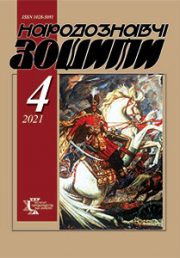The Ethnology Notebooks. 2023. № 5 (173), 1284—1290
UDK 739(04) (477.86) 7.071
п 57
DOI https://doi.org/10.15407/nz2023.05.1284
FORGED BARTKAS / STALINKAS /AND KELEFS (SHEPHERD’S AXES) IN CREATIVE WORK OF MARKO LUKANIUK
POPENIUK Volodymyr
- PhD Candidate in Art History,
- Associate Professor of Kosiv Institute
- of Applied and Decorative Arts
- Lviv National Academy of Arts,
- Department of DA.
- 2, Mitskevycha Str., 78600, Kosiv, Ukraine,
- Contacts: e-mail: v.m.popenuk@gmail.com
Abstract. The article highlights the creative path of the famous Kosiv blacksmith Marko Lukaniuk — an experienced teacher of Kosiv Institute of Applied and Decorative Arts of Lviv National Academy of Arts. The principles of finding innovative national forms of the forged products, in particular bartkas and kelefs, in combination with the traditional heritage of Hutsul metalworking (mosiazhnytstvo) were studied. Attention is focused on the typology of products, artistic and technological features and decorative ornamental weaving and engraving.
Purpose of the article is to highlight the multifaceted artistic creativity as widely as possible, to distinguish the stylistic features of his work.
Relevance. The personality of Marko Lukaniuk is a bright example for young artists in the context of the preservation and development of artistic metal in Kosiv Art School and in the Hutsul region in general.
The source base consists mainly of records and photos that were taken by the author during 2021—2023.
Novelty. For the first time, a variety of new works of art have been made represented to public, which testify to the development trends of modern decorative art.
The article uses comparative and historical methods, art analysis and the use of interviews.
Keywords: artistic metal, forged elements, typology, decor, ornaments, weaving.
Received 4.09.2023
REFERENCES
- Bonkovska, S.M. (1991). Blacksmithing in Ukraine (XIX — early XX centuries). Kyiv: Scientific Opinion [in Ukrainian].
- Valko, O. (2011). Hutsul artistic metal products of the late XVIII — early XXth centuries. Lviv: Institute of Collection of Ukrainian Art Monuments at the National Academy of Sciences [in Ukrainian].
- 3. Zholtovskyi, P.M. (1958). Ornamentation of folk metal products of Hutsulshchyna Folklore and ethnography, 2, 75—92 [in Ukrainian].
- Shuhevich, V. (1901). Hutsulshchyna (Vol. 1). Lviv: Scientific Society named after T. Shevchenko [in Ukrainian].
- Popeniuk, V.M. (2019). The phenomenon of the artistic heritage of Petro Kharinchuk in the history of the development of mosiazhnytstvo (metalworking) of Hutsulshchyna. Bulletin of the Zakarpattia Academy of Arts, 12, 42—47 [in Ukrainian].
- Leontiev, D.V. Architecture of Ukraine. Kharkiv: Ranok Publishing House LLC. [in Ukrainian].
- Sukha, L.M. (1959). Artistic metal products of Ukrainians of the Eastern Carpathians of the second half of the XIX—XX centuries. Kyiv: Academy of Sciences of the SSR [in Ukrainian].
- Nikorak, O. (2004). Ukrainian folk fabric of the 19th—20th centuries: typology, localization, artistic features (Part I: Interior fabrics (based on materials from the western regions of Ukraine). Lviv: Afisha [in Ukrainian].
- Tkachuk, Ya.Yu. (1989). Vasylyna Kalynych bed cover: Catalog of the exhibition. Ivano-Frankivsk [in Ukrainian].
- Matiasiak, I.M. (1954). Hutsul artistic metal products. Kyiv: Academy of Architecture of the USSR [in Ukrainian].






